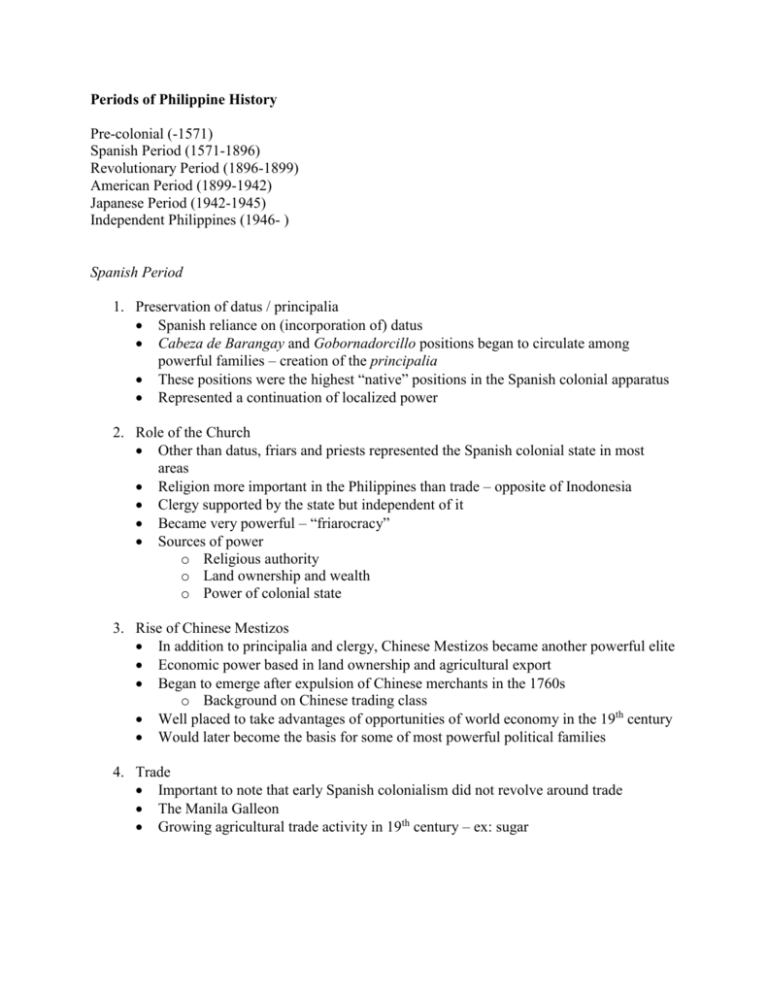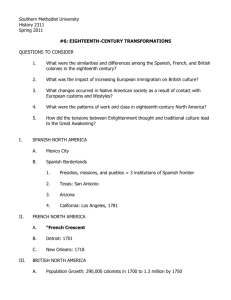Periods of Philippine History
advertisement

Periods of Philippine History Pre-colonial (-1571) Spanish Period (1571-1896) Revolutionary Period (1896-1899) American Period (1899-1942) Japanese Period (1942-1945) Independent Philippines (1946- ) Spanish Period 1. Preservation of datus / principalia Spanish reliance on (incorporation of) datus Cabeza de Barangay and Gobornadorcillo positions began to circulate among powerful families – creation of the principalia These positions were the highest “native” positions in the Spanish colonial apparatus Represented a continuation of localized power 2. Role of the Church Other than datus, friars and priests represented the Spanish colonial state in most areas Religion more important in the Philippines than trade – opposite of Inodonesia Clergy supported by the state but independent of it Became very powerful – “friarocracy” Sources of power o Religious authority o Land ownership and wealth o Power of colonial state 3. Rise of Chinese Mestizos In addition to principalia and clergy, Chinese Mestizos became another powerful elite Economic power based in land ownership and agricultural export Began to emerge after expulsion of Chinese merchants in the 1760s o Background on Chinese trading class Well placed to take advantages of opportunities of world economy in the 19th century Would later become the basis for some of most powerful political families 4. Trade Important to note that early Spanish colonialism did not revolve around trade The Manila Galleon Growing agricultural trade activity in 19th century – ex: sugar Revolutionary Period Latter 19th century saw the rise of two relevant groups of political elites o Ilustrados From wealthiest class Highly educated, often in Spain Rizal and the articulation of nationalism (Noli Me Tangere) Reform o Oficinos Urban middle class Moderate to low formal education Absorbed ideas of Rizal and others More radical / revolutionary Bonifacio, the Katipunan, and the Revolution Leadership passes to Aquinaldo Settlement with the Spanish American Period 1. The “Pacification” The Spanish-American War (1898) The US brings Aguinaldo back to fight the Spanish The fake invasion of Manila The US turns against Aguinaldo A long, bitter war ensues – as many as 1 million Filipinos are killed 2. Political reforms Character of the Philippine Commision, main governing body (1901) The US cultivates the Ilustrados and provincial elite Municipal and provincial elections almost immediately 1907 – elections for a national legislative assembly 1916 – The Jones Act Powerful bicameral legislature Independent Judiciary Limits on power of governor-general Expansion of electorate “Filipinization” of bureaucracy 1934 – Tydings-McDuffie Act Creation of Commonwealth Authorized drafting of constitution Provided for complete independence in 1946 Commonwealth government inaugurated with Quezon as President in 1935 3. Expansion of education Relatively well-educated society (elite) from the Spanish period The US Established universal, free, secular education Initially imported 600 elementary teachers from the US in 1901 High level of expenditures on education (50% in 1922) “Filipinization” of teaching staff 4. Trade Development of special trading relationship Payne-Aldrich Tariff Act (1909), Underwood Tariff Bill (1913) The US established universal, free, secular education Initially imported 600 elementary teachers from the US in 1901 High level of expenditures on education (50% in 1922) “Filipinization” of teaching staff






